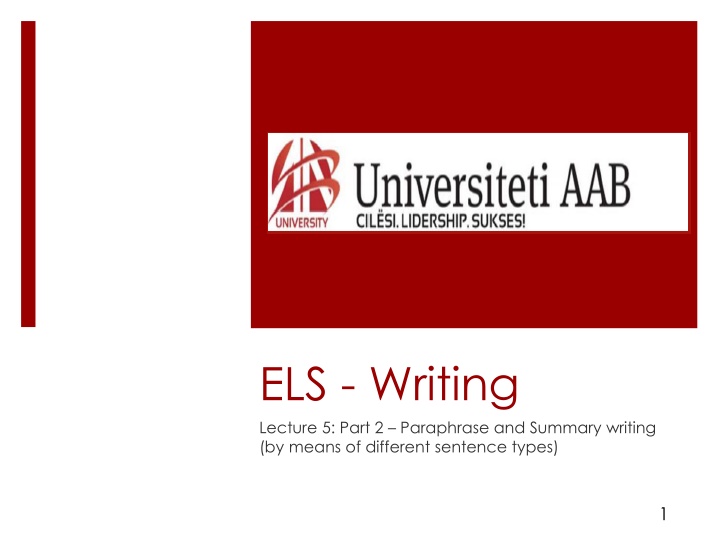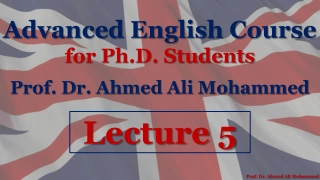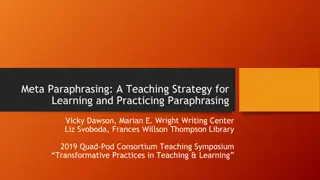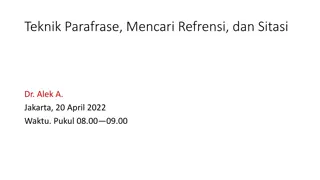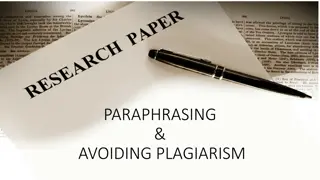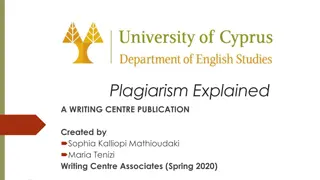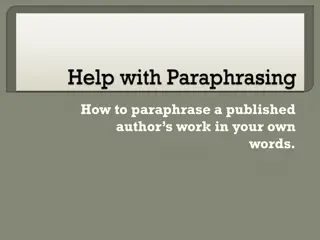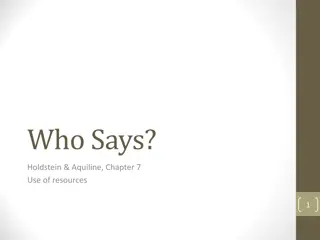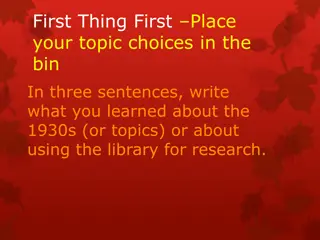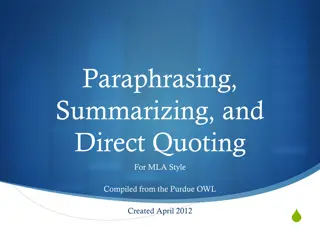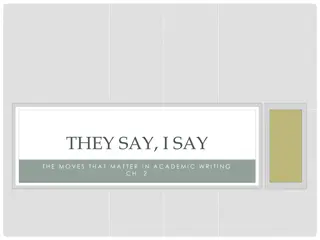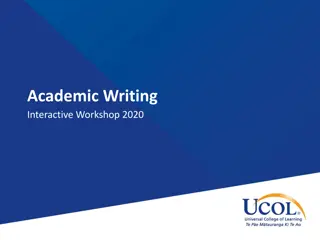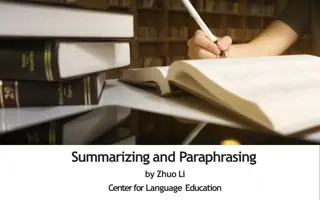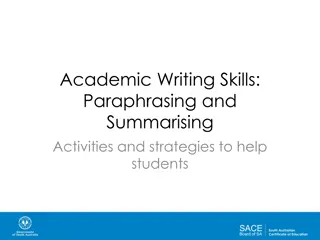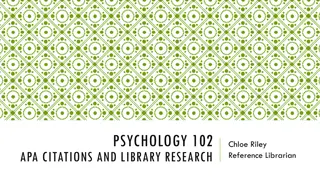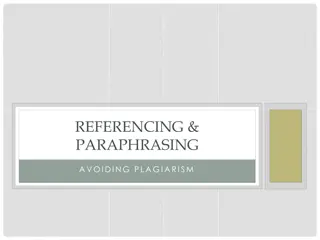Mastering Paraphrasing and Summarizing Techniques
Learn the art of paraphrasing and summarizing by practicing with exercises on rewriting passages from Rosa Parks' essay in your own words. Understand the nuances of sentence structure, word choices, and sentence types to create effective paraphrases. Discover key tips for writing a good paraphrase, such as using original words, shortening the text, and maintaining the original meaning. Follow step-by-step instructions to improve your paraphrasing skills.
Download Presentation

Please find below an Image/Link to download the presentation.
The content on the website is provided AS IS for your information and personal use only. It may not be sold, licensed, or shared on other websites without obtaining consent from the author.If you encounter any issues during the download, it is possible that the publisher has removed the file from their server.
You are allowed to download the files provided on this website for personal or commercial use, subject to the condition that they are used lawfully. All files are the property of their respective owners.
The content on the website is provided AS IS for your information and personal use only. It may not be sold, licensed, or shared on other websites without obtaining consent from the author.
E N D
Presentation Transcript
ELS - Writing Lecture 5: Part 2 Paraphrase and Summary writing (by means of different sentence types) 1
2 Schedule today Finish up last week s exercises Paraphrase and Summary Writing: 1) Paraphrase 2) Summary 2
3 Paraphrase & Summary exercises Paraphrase a single paragraph from the ROSA PARKS essay. Summarize (with the basic triangle structure) the essay of ROSA PARKS Topic sentence Supporting details Concluding remark
4 Paraphrase Paraphrase: - own rendition of someone else s words you rewrite information from an outside source in your own words without changing the meaning. It should be shorter than the original. 4
5 Paraphrase exercise 1
6 Paraphrase exercise 1 Questions: 1. How many sentences are there in the original passage? In the paraphrase? 2. Compare the original passage and the paraphrase sentence by sentence. Analyze how the sentence structure and words differ by answering the following questions: passage? Where does this word appear in the first sentence of the paraphrase? A. What is the first word of the first sentence in the original passage? What word replaces it in the second sentence of the paraphrase? B. What is the first word of the second sentence in the original
7 Paraphrase exercise 1 C. What words replace have dreamed of in the third sentence? What word replaces arguments in favor of in the fourth sentence? D. Which sentence in the original becomes two sentences in the paraphrase? E. Can you identify different sentence types used in the paraphrase? 7
8 How to write a good paraphrase? There are three keys to writing a good paraphrase: 1. Use your own words and your own sentence structure (short long) 2. Make your paraphrase a bit shorter than the original 3. Do not change the meaning of the original 8
You can write a good paraphrase if you follow these steps: 9 Step 1: read the original passage several times until you understand it fully. Look up unfamiliar words, and find synonyms for them. Step 2: set the original apart and write your own paraphrase Step 3: Write a key word (like a title) that indicates the subject of your paraphrase Step 4: Check your wording with the original make sure that your version accurately represents the meaning of the original. Step 4: Use quotation marks to indicate unique terms and phraseology used by the original author Step 5: Record the source 9
10 Paraphrase: Exercise 2 See handout WEEK 5
11 What do we need paraphrasing for? PARAGRAPH STRUCTURE The purpose is to be able to use Paraphrases as supporting material in your writing. Supporting details 11
12 Example original passage
13 as a paraphrase in the completed paragraph
14 Summary Only the main points are borrowed from the original author/text-producer SIGNIFICANTLY shorter Leave out the details (so not detail-oriented) 14
15 How to write a good summary? There are three keys to writing a good summary: 1) Use your own words and own sentence structures (short long) 2) Include only the main points and leave out most of the details. 3) Do not change the meaning of the original. 15
16 Summary: exercise 1 See handout: Read the original passage and the two summaries that follow it. Then answer the following questions: 1) Which of the two is the better summary? Why? 2) Can you identify different sentence types? 3) Which summary contains an idea that was not in the original? Which sentence expresses that idea? 16
17 Summary: exercise 2 Write your own summary based on the example of the next slide 17
18 Summary: exercise 2
19 The differences The original passage: Students frequently overuse direct quotation in taking notes, and as a result they overuse quotations in the final [research] paper. Probably only about 10% of your final manuscript should appear as directly quoted matter. Therefore, you should strive to limit the amount of exact transcribing of source materials while taking notes. Lester, James D. Writing Research Papers. 2nd ed. (1976): 46-47. A legitimate paraphrase: In research papers students often quote excessively, failing to keep quoted material down to a desirable level. Since the problem usually originates during note taking, it is essential to minimize the material recorded verbatim (Lester 46-47). An acceptable summary: Students should take just a few notes in direct quotation from sources to help minimize the amount of quoted material in a research paper (Lester 46-47).
